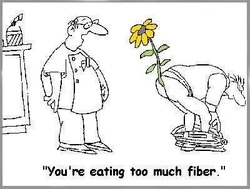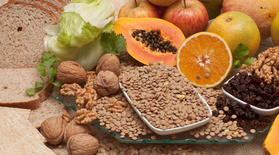 Fiber. It’s one of those nutrients we often hear about, but did you know that most Americans are deficient in it? Public health guidelines from the US Food and Drug Administration (FDA) advise Americans to eat between 20 and 38 grams of fiber a day, but most adults don’t even eat half that much. This post will describe what fiber is, its fabulous health benefits and how we can ramp up our intake. (And I promise you won't grow a sunflower out of your bum!) Dietary fiber is basically the parts of plant foods that our bodies can't digest or absorb. It passes relatively intact through our stomach, small intestine, colon and out of our body. Fiber is present in all plants that are eaten for food, including fruits, vegetables, grains, beans, lentils and peas. Though there are many types of fiber, they are generally categorized as either “soluble” or "insoluble”. Soluble fiber dissolves in water to form a gel-like texture, helping to slow down your digestion and make you feel full. These fibers help lower cholesterol and help regulate blood sugar levels. Soluble fiber is found in oats, lentils, apples, oranges, pears, strawberries, nuts, flaxseeds, beans, dried peas, blueberries, psyllium, cucumbers, celery, and carrots. Insoluble fiber does not dissolve in water and adds bulk to your stool and speeds up the passage of food and waste through your gut, helping prevent constipation. It also helps regulate your intestine’s pH. It is found in whole grains such as whole wheat, barley, brown rice and bulgar, nuts and seeds, zucchini, celery, broccoli, cabbage, onions, tomatoes, carrots, cucumbers, green beans, dark leafy vegetables, raisins, grapes, and root vegetable skins. Most plant-based foods, such as oatmeal and beans, contain both soluble and insoluble fiber. However, the amount of each type varies in different plant foods. Eating a wide variety of fibers is the ideal solution to gaining all the health benefits. Benefits of a high-fiber diet:
Ways to boost your intake: We should get at least 20 grams of fiber a day, but more is better. Slowly adding more fiber to your diet can avoid bloating and gas by giving your body time to adapt. It is also important to drink plenty of liquids while increasing fiber.
4 Comments
 Last week I introduced research indicating that the risks of diseases such as type 2 diabetes and coronary heart disease are strongly related to the glycemic index (GI) of our overall diet. Typically foods with high GI’s are high in sugar and/or starch (think desserts, white flour, cereals, rice, potatoes). But what can we do to lower a foods impact on our blood sugar if we do choose to eat a cupcake or some potato chips (preferably baked - here's a great recipe I use), which are high-GI foods? I recently finished reading The Sugar Blockers Diet (thanks for the recommendation Ilana!) and learned about sugar blockers, or ways we can slow the absorption of glucose into our blood stream. These various means to block sugar are powerful since, according to research in the book, reducing the size of after-meal blood sugar spikes by just 30% reduces insulin demands, promotes weight loss, makes diabetes easier to control and can actually reverse prediabetes. If knowledge is power, here’s to power! Sugar blocking power! 1. Increase particle size: Ways to increase the size of carbohydrates particles that reach your stomach. Example: Cook your pasta al dente, or slightly undercooked. It will take longer to digest and raise your blood sugar less than if you over cook it. Try it out and let me know how you like it! 2. Stomach barriers: Things you can do to physically impeded the passage of carbohydrates from your stomach to your intestine. Example: Eat something fibrous (like a salad) before your meal. 3. Intestinal “brakes”: Substances that slow stomach emptying. Example: Eat a handful of nuts or a piece of cheese before a meal. 4. Enzyme inhibitors: Substances that inhibit enzymes that break down starch into sugar. Example: Amylase is a digestive enzyme that breaks down starches into smaller carbohydrate molecules. It is secreted by our salivary glands and pancreas. Vinegar inhibits amylase and is thus a sugar blocker. Eat a salad with a vinegar-based dressing to lower your after-meal blood sugar level. Vinegar-based dressings are always a healthy choice over cream-based and they're so easy to make! I make this balsamic vinaigrette often. 5. Sugar sponges: Substances that soak up glucose in your digestive tract. Example: Foods or supplements high in soluble fiber (found in legumes like beans and peas, oats, seeds and nuts, some vegetables and fruit). I will discuss the different types of fiber in depth in my next post. 6. Liver helpers: Substances that enhance your liver’s ability to take up glucose released into your bloodstream during meals. Example: Our liver is our second largest organ that performs many essential functions related to digestion, metabolism, immunity, and the storage of nutrients within the body. Alcohol helps the liver take up glucose after you eat, so enjoy a glass of wine or even a shot before your meal. I personally love beer, but it tends to have more carbs than wine or liquor so choose wisely and watch for portion sizes. 7. First-phase simulators: Ways to get the beta cells of our pancreas to secrete insulin sooner rather than later, making it more effective. Example: Protein triggers the first-phase insulin response, so eat an egg with your toast or meatball with your spaghetti. 8. Insulin sensitizers: Techniques that sensitize your body to insulin so that less is needed to handle the after-meal glucose surge. Example: Reduced sensitivity to insulin is a major contributor to type 2 diabetes. The one cure for insulin resistance is exercise, so be sure to exercise every 24 to 48 hours. A 20 minute walk is sufficient. Resistance exercises (lifting weights, pushups, pull-ups, etc.) are effective too since the more muscle cells we have the more glucose they absorb. 9. After-meal exercise: Taking advantage of your muscles’ ability to remove sugar from your bloodstream without insulin. Example: Taking a walk after a meal. |
AuthorHello and welcome! My name is Andrea Notch Mayzeles. I am a Certified Health Education Specialist, Mom, and Master of Public Health dedicated to the path of well-being. As a wellness professional I am committed to continued learning and am here to share research, recipes and musings on health, psychology, personal development, and parenting. I hope you enjoy! Categories
All
|

 RSS Feed
RSS Feed